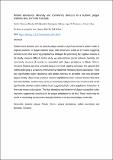| dc.description.abstract | Rodent-borne diseases such as bubonic plague remain a significant threat to public health in tropical countries. In plague-endemic areas, little information exists on the factors triggering periodic bursts, thus rendering preparedness strategies for preventing the negative impacts of the deadly zoonosis difficult. In this study, we assessed how species richness, diversity, and community structure of rodents are associated with plague persistence in Mbulu District, Tanzania. Rodent data were collected using the removal trapping technique. We captured 610 rodents belonging to 12 species, with Mastomys natalensis recording highest abundance. There was significantly higher abundance and species richness in persistent than non-persistent plague locality. Also, house premises recorded significantly lower species richness than farm and forest habitats. Additionally, we found three broad rodent community structures that varied significantly between studied habitat types suggesting high rodent populations interaction at fine-scale resource abundance. The high abundance and diversity of plague-susceptible rodent reservoirs suggestively contribute to the plague persistence in the foci. These results may be useful to developing preparedness strategies in these areas to control plague outbreaks. | en_US |

